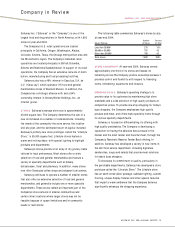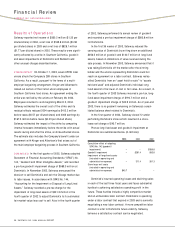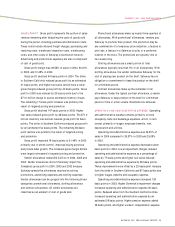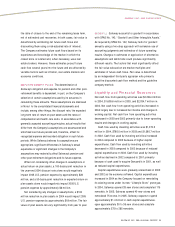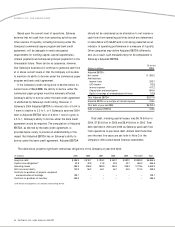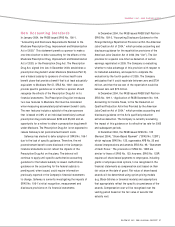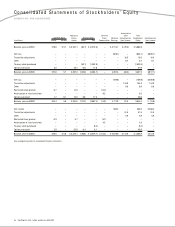Safeway 2004 Annual Report Download - page 27
Download and view the complete annual report
Please find page 27 of the 2004 Safeway annual report below. You can navigate through the pages in the report by either clicking on the pages listed below, or by using the keyword search tool below to find specific information within the annual report.
SAFEWAY INC. 2004 ANNUAL REPORT 25
SAFEWAY INC. AND SUBSIDIARIES
the date of closure to the end of the remaining lease term,
net of estimated cost recoveries. In both cases, fair value is
determined by estimating net future cash flows and
discounting them using a risk-adjusted rate of interest.
The Company estimates future cash flows based on its
experience and knowledge of the market in which the
closed store is located and, when necessary, uses real
estate brokers. However, these estimates project future
cash flow several years into the future and are affected by
variable factors such as inflation, real estate markets and
economic conditions.
EMPLOYEE BENEFIT PLANS The determination of
Safeway’s obligation and expense for pension and other post-
retirement benefits is dependent, in part, on the Company’s
selection of certain assumptions used by its actuaries in
calculating these amounts. These assumptions are disclosed
in Note I to the consolidated financial statements and
include, among other things, the discount rate, the expected
long-term rate of return on plan assets and the rates of
compensation and health care costs. In accordance with
generally accepted accounting principles, actual results that
differ from the Company’s assumptions are accumulated and
amortized over future periods and, therefore, affect its
recognized expense and recorded obligation in such future
periods. While Safeway believes its assumptions are
appropriate, significant differences in Safeway’s actual
experience or significant changes in the Company’s
assumptions may materially affect Safeway’s pension and
other post-retirement obligations and its future expense.
When not considering other changes in assumptions or
actual return on plan assets, a 100-basis-point reduction in
the year-end 2004 discount rate alone would negatively
impact 2005 U.S. pension expense by approximately $28
million, and a 50-basis-point reduction in expected return on
plan assets alone would negatively impact 2005 U.S.
pension expense by approximately $8 million.
Not considering any changes in assumptions, a $100
million reduction in plan assets in 2004 would impact 2005
U.S. pension expense by approximately $18 million. The fair
value of plan assets can vary significantly from year to year.
GOODWILL Safeway accounts for goodwill in accordance
with SFAS No. 142, “Goodwill and Other Intangible Assets.”
As required by SFAS No. 142, Safeway tests for goodwill
annually using a two-step approach with extensive use of
accounting judgments and estimates of future operating
results. Changes in estimates or application of alternative
assumptions and definitions could produce significantly
different results. The factors that most significantly affect
the fair value calculation are market multiples and
estimates of future cash flows. Fair value is determined
by an independent third-party appraiser who primarily
used the discounted cash flow method and the guideline
company method.
Liquidity and Financial Resources
Net cash flow from operating activities was $2,226.4 million
in 2004, $1,609.6 million in 2003, and $2,034.7 million in
2002. Net cash flow from operating activities increased in
2004 largely due to increased net income and changes in
working capital. Net cash flow from operating activities
decreased in 2003 and 2002 primarily due to lower operating
results and changes in working capital.
Cash flow used by investing activities was $1,070.3
million in 2004, $795.0 million in 2003 and $1,395.7 million
in 2002. Cash flow used by investing activities increased
in 2004 compared to 2003 because of higher capital
expenditures. Cash flow used by investing activities
decreased in 2003 compared to 2002 because of reduced
capital expenditures in 2003. Cash flow used by investing
activities declined in 2002 compared to 2001 primarily
because of cash used to acquire Genuardi’s in 2001, as well
as reduced capital expenditures.
Capital expenditures were gradually scaled back in 2003
and 2002 as the economy softened. Capital expenditures
increased in 2004 as the Company focused on remodeling
its existing stores under its new “Lifestyle Store” prototype.
In 2004, Safeway opened 33 new stores and completed 115
remodels. In 2003, Safeway opened 40 new stores and
remodeled 75 stores. In 2005, Safeway expects to spend
approximately $1.4 billion in cash capital expenditures,
open approximately 30 to 35 new stores and complete
approximately 275 to 285 remodels.


